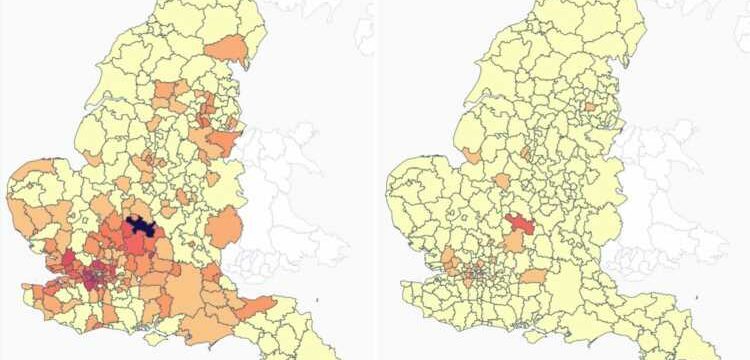A NEW map reveals some of the earliest places hit with the Omicron variant, which is now spreading rapidly in the UK.
Hotspots have emerged, focused mostly in the South East and London.
But it is Northamptonshire that has the highest number of infections, according to the Wellcome Sanger Institute.
The genetic research centre tracks Covid variants and details where they are most prevalent with a lag of around two weeks.
Its latest map, using data to December 4, reveals South Northamptonshire was reporting 26 Omicron cases a week, with surrounding areas also hotspots.
But Lewisham is the second most affected area, with 10 cases a week.
Other London boroughs with higher cases include Newham and Barking and Dagenham.
Infections are now several times higher than the map portrays, as the Omicron variant is doubling in case numbers every two days.
Leading scientist Dr Jeffrey Barrett, Director of the COVID-19 Genomics Initiative at the Wellcome Sanger Institute, suggested the team could not keep up with the outbreak and provide a relevant map.
He wrote on Twitter: “We publish on a 9-day lag (so the most recent week has complete data) and average over two weeks (to smooth patterns).
Most read in Health
LAST ORDERS New Year's Eve parties under threat by killjoy Whitehall officials in new plans
'Pubs and restaurants could be CLOSED or have entry limits to halt Omicron'
I'm proud to support Jabs Army – you give us hope, says Camilla
NHS England moves to highest alert level as Omicron cases up by HALF in 24 hours
“Both of these mean we are laughably behind the curve with this variant.”
Dr Barrett said the UK Health and Security Agency (UKHSA) has more up-to-date information on the way Omicron is spreading across the country.
🔵 Read our Covid-19 live blog for the latest updates
Last week it gave its first list of Omicron hotspots, with West Northamptonshire top, followed by London boroughs of Croydon, Hackney, Lambeth and Newham.
UKHSA said the majority of cases are in the capital and South East.
Omicron is already accounting for at least 40 per cent of cases in London less than two weeks after it was first detected, followed by 20 per cent in the South East.
It comes after the Health Secretary claimed Omicron would likely become dominant in the capital in “the next 48 hours”.
Savid Javid told MPs there are now 4,713 confirmed cases of Omicron in the UK, but that the UKHSA estimates that the current number of “daily infections are around 200,000”.
Earlier, he said there were 10 hospitalisations and Boris Johnson announced the first UK deathhttps://www.thesun.co.uk/health/17024782/patient-omicron-dies-mutant-variant-uk/ with Omicron.
The UK in a race to booster-jab all adults faster than Omicron spreads, and from Wednesday, every eligible adult over 18 years old in the UK will be able to book their top-up shot.
Experts have warned that based on early data, two doses of the vaccines are almost ineffective against Omicron, but a third dose will bring protection from symptoms back up to 75 per cent.
The Sun’s Jabs Army is recruiting 30,000 to help turbocharge the national mission to drive down the Covid variant and save Christmas.
Even with the “Plan B” measures and boosters, there is an unstoppable “tsunami” of cases over the horizon.
POSITIVE NEWS
However, there is positive data coming from South Africa, which was first hit with the variant.
Cases in the hotspots of Gauteng province and the city of Tshwane appear to be stabilising, experts say.
"Case growth is steeper than last week but still has slowed down versus November," said Louis Rossouw, of the Covid-19 Actuaries Response Group in South Africa, according to The Telegraph.
"In Gauteng, cases are still levelling off. Tshwane cases are relatively flat, with a slight increase in the most recent days."
According to South Africa’s National Institute for Communicable Diseases, 30 per cent of those hospitalised with Covid in recent weeks have been seriously ill – less than half the rate as during the first weeks of previous pandemic waves.
Some three per cent of patients hospitalised have died, versus about 20 per cent in the country’s earlier outbreaks.
The data further supports that Omicron is a more mild disease – which may be due to the higher levels of protection gained from natural infection and vaccinations.
At a briefing in London on Monday, Matthew Snape, professor in paediatrics and vaccinology at the University of Oxford, said: "In areas where we know Omicron has been circulating for a bit longer, such as in South Africa, they are not seeing severe disease, maybe because they actually still have enough cross-reactive antibodies.”
In the UK, hospital and death rates are still stable. But experts say any impact of severe disease caused by Omicron would not show for another couple of weeks.
Cases, however, are surging.
There were 54,661 people diagnosed yesterday. And the seven-day total (363,682) is 10 per cent higher than the previous week.
Plymouth, Devon, is seeing the highest case rate in the whole of the UK, with 869 cases per 100,000 people.
It’s followed by Newry, Mourne and Down (853), Northern Ireland, and Milton Keynes (794), Buckinghamshire.
Source: Read Full Article






